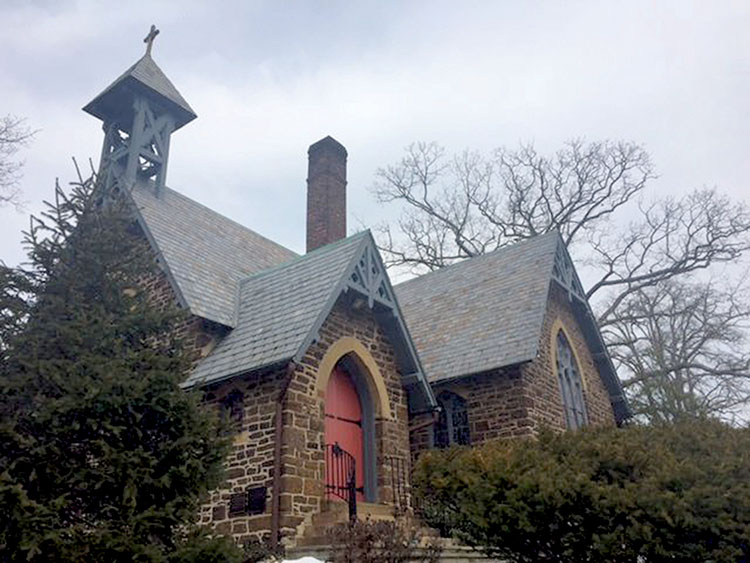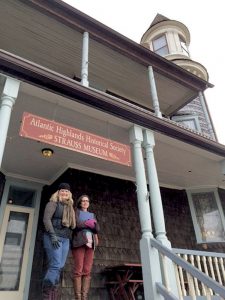Story and photos by Rick Geffken |
Well-known and beloved Two Rivers area landmarks, the All Saints’ Memorial Church and the Strauss House Mansion, were recently awarded separate grants by the New Jersey Historic Trust. The Episcopal house of worship in Navesink, often referred to as “the Stone Church,” was awarded $150,000 for repairs to its slate-shingled roof. The Strauss Mansion, home of the Atlantic Highlands Historical Society, will receive $133,448 for stabilization and repairs.
Established in 1967, the New Jersey Historic Trust is the only nonprofit historic preservation organization New Jersey created by state laws. Its mission is to advance historic preservation for the benefit of future generations. It does this with a number of programs in education, stewardship and financial investment to save our shared heritage and strengthen our communities.
All Saints’ Parish dates to 1861 when Dr. William N. Dunnell, the Rector of Trinity Church in Red Bank, began holding services in the area known then as Riceville. An enthusiastic churchman, Charles Milnor was soon gathering his children and others for Sunday School instructions in a little cottage he owned there. According to All Saints’ Church history, “The ladies of the Milnor family, assisted by others in the neighborhood, acted as teachers.”
John H. Stephens, another congregant of the burgeoning parish, determined to build a chapel in memory of his late daughter, Mrs. James Edgar, who had long cherished a dream of one. Stephens hired Richard Upjohn of the noted father and son architectural firm to design All Saints’ Memorial Chapel. Upjohn Senior, who immigrated to the United States from Britain and is still revered for his Gothic Revival churches, was also a co-founder of the American Institute of Architects.
The All Saints’ Memorial Chapel cornerstone was laid in October 1863, and was “consecrated to the honor and glory of Almighty God” in September 1864. It was designated a National Historic Landmark in 1988. Among the original wardens and vestrymen were members of noteworthy Monmouth County families such as Hartshorne, Sickles, Milnor, and Stephens.

Located on a gentle rise from Claypit Creek, at the intersection where Navesink and Monmouth Avenues converge with Hartshorne Road, the four-acre setting of All Saints’ is one of the most picturesque settings in Middletown, if not in Monmouth County.
The simple aesthetics of the interior of the Stone Church feature white-washed walls highlighted and well-lighted by the beautiful stained glass windows. An unusual feature is the altar location of the pipe organ, added some years after the chapel was built. The floor tiles were crafted by the English firm of Johnson Tiles. Still in business, the Stoke-on-Trent business is now replicating replacements for several damaged and missing tiles for the church.
Both All Saint’s Church and the Twin Lights (completed in May 1862 on nearby Mount Mitchill) were built during the Civil War years – nods to God and Mammon during a tumultuous time in our nation’s history.
The current rector of All Saints’ is Debbie Cook, who spent most of her youth in nearby Freehold. Ordained into the ministry ten years ago after a career as an accountant, she was assigned to All Saint’s in 2014. Mother Cook outlined the Historic Trust Grant process this way: “People on our Landmark Trust helped me write the application in- house, saving the money had we hired a consultant. Grantees are required to put up project money first, and then are reimbursed from the New Jersey Historic Trust. It took over a year before the decision was made, but we got the maximum allowed. We asked for $150,000 and that’s what we got.”
The award decision is, however, only the beginning of a drawn-out process. Because grant money comes from NJ corporate business taxes, once the Historic Trust announces grant awards, the state legislature and the governor must approve them before the monies are distributed to recipients. It will be several more months before this happens. Even then the Church will be reimbursed on a gradual “cost to date” basis – submitting bills for the repairs as they are completed.
“Luckily,” Mother Cook continued, “we have enough in our Treasury to proceed. We’re gathering construction bids now and hope to begin work on the Rectory roof as soon as the weather breaks in the spring.” She also noted that a previous 1960s repair to the roofs used inferior slate. “The roof itself is large, with a complicated fancy pattern, probably original to the building. The ‘Yankee gutter’ system will also be redone when they work on the roof.”
Mother Cook is happy to report the average Sunday attendance at the Church is approaching a hundred people and growing. “It’s a challenge to increase our congregation because this isn’t a modern facility, but it’s historic and the people who come like that it’s small and cozy. And the heat and air conditioning both work!”
More than a house of worship “built for God’s mission,” All Saints’ plays an active role in the greater Middletown community. The Church hosts concerts, auctions, pancake suppers, community meetings, and other secular events throughout the year. The St. Patrick’s Day dinner on March 18th will raise money for a local food pantry. Local high school students will be appearing at an All Saints’ production of Romeo and Juliet in June.
In a coincidental happenstance, Lynn Fylak, one of the All Saints’ Trustees, is also the President of the Atlantic Highlands Historical Society, the other local recipient of a New Jersey Historic Trust Grant. The welcomed funds will be used for repairs to the Strauss House Museum, built in 1893 by Manhattan merchant Adolph Strauss as a summer residence for his family.

Like other wealthy businessmen of his time, Strauss valued Atlantic Highlands’s easy steamboat proximity to his New York offices. The twenty-one room Strauss home was the first of many grand residences that were built on the exclusive Prospect Circle in Atlantic Highlands within months of each other.
After a 125 years, the mansion’s ornately carved interior woodwork, multicolored stained glass, inlayed fireplace mantels, and private servants’ stairwells are worn and fading. The parquet oak flooring has marginally withstood years of neglect. Shoddily done modern additions during a period when the house was a rental unit, not to mention northeastern winter storms, also took a toll.
The Strauss House was rescued from demolition by the Atlantic Highlands Historical Society which purchased it in 1980. Like many historical societies, enthusiasm waned from time to time. Several years ago a new group began bringing the Strauss House back to life with energetic volunteers. The Society runs annual fund-raising events such as local house tours, flea markets, arts and crafts shows, movie screenings, jazz nights, and even paranormal investigations around Halloween each year. Still, maintaining an old home and ensuring it is up to modern fire and safety codes are expensive undertakings.
Society President Fylak explains that “Our 15 board members and numerous volunteers are dedicated to keeping this place going. The board of directors was delighted when the Society got a letter from the New Jersey Historic Trust in the late fall announcing the $133,000 award.”
Phase one of the Atlantic Highlands Historical Society Preservation Plan is the stabilization of the exterior of the Strauss House. Archaeologist and historian Jean Howson is Vice President of the organization. “The grant money is earmarked for stabilizing the main support beam of the house,” she says. “Restoring the wrap-around porch, while repairing or replacing the supporting columns is vital. When we conducted a mortar assessment of the foundation as part of our preservation plan, we were able to determine the original specs of the mortar. We’ll repoint it with an identical composition.”
As generous and helpful as the historic grant will be, “It’s a three-to-two matching grant.” says Howson. “Our stabilization and reconstruction project will cost over $222,000. Annual and on-going fund raising brings in about $35,000. We used grants from the private 1772 Foundation and the Monmouth County Historical Commission to qualify for the Historic Trust grant.” And, just as at All Saints’, the grant monies will be doled out as work is completed and billed.
President Fylak couldn’t be more pleased with what the Society has accomplished to date. “We want to help the Atlantic Highlands community in general, and insure the Strauss House is around for years to come. We were overjoyed and proud that the New Jersey Historic Trust grant acknowledged the hard work we’ve put in for the last four years.”
If you’d like to know more about these landmarks, contact Mother Cook at All Saints’ Memorial Chapel at mother.debbie@comcast.net; and/or the Atlantic Highlands Historical Society website at www.AHhistory.org.
This article was first published in the Feb. 16-23, 2017 print edition of The Two River Times.














